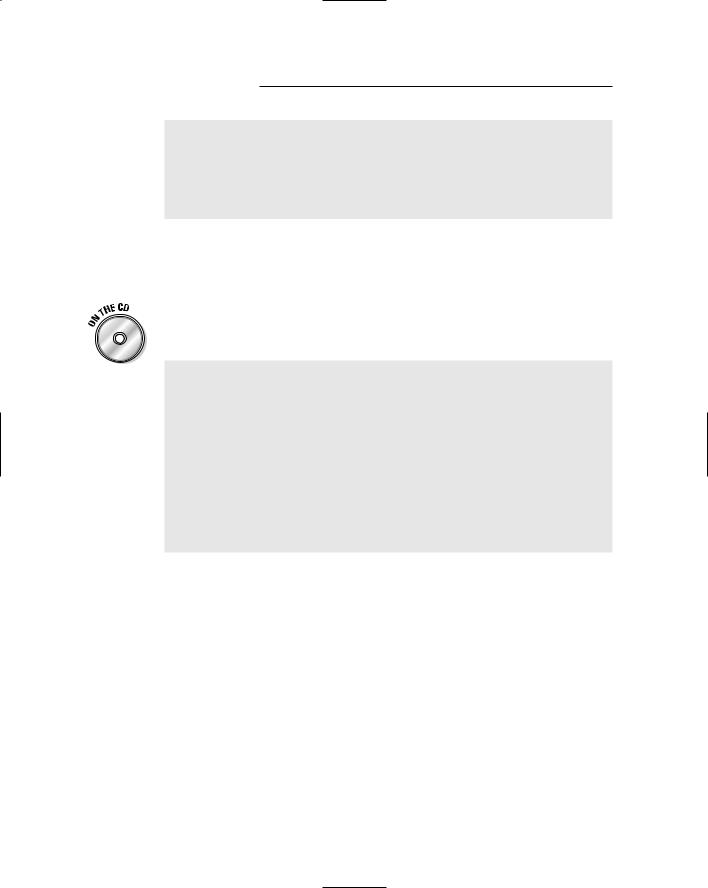
- •Table of Contents
- •Introduction
- •What Is C++?
- •Conventions Used in This Book
- •How This Book Is Organized
- •Part I: Introduction to C++ Programming
- •Part III: Introduction to Classes
- •Part IV: Inheritance
- •Part V: Optional Features
- •Part VI: The Part of Tens
- •Icons Used in This Book
- •Where to Go from Here
- •Grasping C++ Concepts
- •How do I program?
- •Installing Dev-C++
- •Setting the options
- •Creating Your First C++ Program
- •Entering the C++ code
- •Building your program
- •Executing Your Program
- •Dev-C++ is not Windows
- •Dev-C++ help
- •Reviewing the Annotated Program
- •Examining the framework for all C++ programs
- •Clarifying source code with comments
- •Basing programs on C++ statements
- •Writing declarations
- •Generating output
- •Calculating Expressions
- •Storing the results of expression
- •Declaring Variables
- •Declaring Different Types of Variables
- •Reviewing the limitations of integers in C++
- •Solving the truncation problem
- •Looking at the limits of floating-point numbers
- •Declaring Variable Types
- •Types of constants
- •Special characters
- •Are These Calculations Really Logical?
- •Mixed Mode Expressions
- •Performing Simple Binary Arithmetic
- •Decomposing Expressions
- •Determining the Order of Operations
- •Performing Unary Operations
- •Using Assignment Operators
- •Why Mess with Logical Operations?
- •Using the Simple Logical Operators
- •Storing logical values
- •Using logical int variables
- •Be careful performing logical operations on floating-point variables
- •Expressing Binary Numbers
- •The decimal number system
- •Other number systems
- •The binary number system
- •Performing Bitwise Logical Operations
- •The single bit operators
- •Using the bitwise operators
- •A simple test
- •Do something logical with logical calculations
- •Controlling Program Flow with the Branch Commands
- •Executing Loops in a Program
- •Looping while a condition is true
- •Using the for loop
- •Avoiding the dreaded infinite loop
- •Applying special loop controls
- •Nesting Control Commands
- •Switching to a Different Subject?
- •Writing and Using a Function
- •Divide and conquer
- •Understanding the Details of Functions
- •Understanding simple functions
- •Understanding functions with arguments
- •Overloading Function Names
- •Defining Function Prototypes
- •Variable Storage Types
- •Including Include Files
- •Considering the Need for Arrays
- •Using an array
- •Initializing an array
- •Accessing too far into an array
- •Using arrays
- •Defining and using arrays of arrays
- •Using Arrays of Characters
- •Creating an array of characters
- •Creating a string of characters
- •Manipulating Strings with Character
- •String-ing Along Variables
- •Variable Size
- •Address Operators
- •Using Pointer Variables
- •Comparing pointers and houses
- •Using different types of pointers
- •Passing Pointers to Functions
- •Passing by value
- •Passing pointer values
- •Passing by reference
- •Limiting scope
- •Examining the scope problem
- •Providing a solution using the heap
- •Defining Operations on Pointer Variables
- •Re-examining arrays in light of pointer variables
- •Applying operators to the address of an array
- •Expanding pointer operations to a string
- •Justifying pointer-based string manipulation
- •Applying operators to pointer types other than char
- •Contrasting a pointer with an array
- •Declaring and Using Arrays of Pointers
- •Utilizing arrays of character strings
- •Identifying Types of Errors
- •Choosing the WRITE Technique for the Problem
- •Catching bug #1
- •Catching bug #2
- •Calling for the Debugger
- •Defining the debugger
- •Finding commonalities among us
- •Running a test program
- •Single-stepping through a program
- •Abstracting Microwave Ovens
- •Preparing functional nachos
- •Preparing object-oriented nachos
- •Classifying Microwave Ovens
- •Why Classify?
- •Introducing the Class
- •The Format of a Class
- •Accessing the Members of a Class
- •Activating Our Objects
- •Simulating real-world objects
- •Why bother with member functions?
- •Adding a Member Function
- •Creating a member function
- •Naming class members
- •Calling a Member Function
- •Accessing a member function
- •Accessing other members from a member function
- •Defining a Member Function in the Class
- •Keeping a Member Function After Class
- •Overloading Member Functions
- •Defining Arrays of and Pointers to Simple Things
- •Declaring Arrays of Objects
- •Declaring Pointers to Objects
- •Dereferencing an object pointer
- •Pointing toward arrow pointers
- •Passing Objects to Functions
- •Calling a function with an object value
- •Calling a function with an object pointer
- •Calling a function by using the reference operator
- •Returning to the Heap
- •Comparing Pointers to References
- •Linking Up with Linked Lists
- •Performing other operations on a linked list
- •Hooking up with a LinkedListData program
- •A Ray of Hope: A List of Containers Linked to the C++ Library
- •Protecting Members
- •Why you need protected members
- •Discovering how protected members work
- •Protecting the internal state of the class
- •Using a class with a limited interface
- •Creating Objects
- •Using Constructors
- •Why you need constructors
- •Making constructors work
- •Dissecting a Destructor
- •Why you need the destructor
- •Working with destructors
- •Outfitting Constructors with Arguments
- •Justifying constructors
- •Using a constructor
- •Defaulting Default Constructors
- •Constructing Class Members
- •Constructing a complex data member
- •Constructing a constant data member
- •Constructing the Order of Construction
- •Local objects construct in order
- •Static objects construct only once
- •Global objects construct in no particular order
- •Members construct in the order in which they are declared
- •Destructors destruct in the reverse order of the constructors
- •Copying an Object
- •Why you need the copy constructor
- •Using the copy constructor
- •The Automatic Copy Constructor
- •Creating Shallow Copies versus Deep Copies
- •Avoiding temporaries, permanently
- •Defining a Static Member
- •Why you need static members
- •Using static members
- •Referencing static data members
- •Uses for static data members
- •Declaring Static Member Functions
- •What Is This About, Anyway?
- •Do I Need My Inheritance?
- •How Does a Class Inherit?
- •Using a subclass
- •Constructing a subclass
- •Destructing a subclass
- •Having a HAS_A Relationship
- •Why You Need Polymorphism
- •How Polymorphism Works
- •When Is a Virtual Function Not?
- •Considering Virtual Considerations
- •Factoring
- •Implementing Abstract Classes
- •Describing the abstract class concept
- •Making an honest class out of an abstract class
- •Passing abstract classes
- •Factoring C++ Source Code
- •Defining a namespace
- •Implementing Student
- •Implementing an application
- •Project file
- •Creating a project file under Dev-C++
- •Comparing Operators with Functions
- •Inserting a New Operator
- •Overloading the Assignment Operator
- •Protecting the Escape Hatch
- •How Stream I/O Works
- •The fstream Subclasses
- •Reading Directly from a Stream
- •Using the strstream Subclasses
- •Manipulating Manipulators
- •Justifying a New Error Mechanism?
- •Examining the Exception Mechanism
- •What Kinds of Things Can I Throw?
- •Adding Virtual Inheritance
- •Voicing a Contrary Opinion
- •Generalizing a Function into a Template
- •Template Classes
- •Do I Really Need Template Classes?
- •Tips for Using Templates
- •The string Container
- •The list Containers
- •Iterators
- •Using Maps
- •Enabling All Warnings and Error Messages
- •Insisting on Clean Compiles
- •Limiting the Visibility
- •Avoid Overloading Operators
- •Heap Handling
- •Using Exceptions to Handle Errors
- •Avoiding Multiple Inheritance
- •Customize Editor Settings to Your Taste
- •Highlight Matching Braces/Parentheses
- •Enable Exception Handling
- •Include Debugging Information (Sometimes)
- •Create a Project File
- •Customize the Help Menu
- •Reset Breakpoints after Editing the File
- •Avoid Illegal Filenames
- •Include #include Files in Your Project
- •Executing the Profiler
- •System Requirements
- •Using the CD with Microsoft Windows
- •Using the CD with Linux
- •Development tools
- •Program source code
- •Index

Chapter 23: A New Assignment Operator, Should You Decide to Accept It 311
This is what enables the programmer to write the following:
d2 = d1 = 2.0
fn(d2 = 3.0); // performs the assignment and passes the // resulting value to fn()
The value of the assignment d1 = 2.0 (2.0) and the type (double) are passed to the assignment to d2. In the second example, the value of the assignment d2 = 3.0 is passed to the function fn().
The second detail is that operator=() was written as a member function. The left-hand argument is taken to be the current object (this). Unlike other operators, the assignment operator cannot be overloaded with a nonmember function.
Protecting the Escape Hatch
Providing your class with an assignment operator can add considerable flexi bility to the application code. However, if this is too much work or if you don’t want C++ to make copies of your object, overloading the assignment operator with a protected function will keep anyone from accidentally making an unau thorized member-by-member shallow copy, as illustrated here:
class Name
{
//...just like before...
protected:
// copy constructor Name(Name&) {} //assignment operator
Name& operator=(Name& s) { return *this; }
};
With this definition, assignments such as the following are precluded:
void fn(Name &n)
{
Name newN;
newN = n; //generates a compiler error - //function has no access to op=()
}
This copy protection for classes saves you the trouble of overloading the assignment operator but reduces the flexibility of your class.
If your class allocates resources such as memory off the heap, you must either write a satisfactory assignment operator and copy constructor or make both protected to preclude the default provided by C++ from being used.

312 Part V: Optional Features

Chapter 24
Using Stream I/O
In This Chapter
Performing input/output
Rediscovering stream I/O as an overloaded operator
Using stream file I/O
Using stream buffer I/O
Going behind the scenes with manipulators
Programs appearing before this chapter read from the cin input object and output through the cout output object. Perhaps you haven’t really
thought about it much, but this input/output technique is a subset of what is known as stream I/O.
In this chapter, I describe stream I/O in more detail. I must warn you that stream I/O is too large a topic to be covered completely in a single chapter — entire books are devoted to this one topic. Fortunately for both of us, there isn’t all that much that you need to know about stream I/O in order to write the vast majority of programs.
How Stream I/O Works
Stream I/O is based on overloaded versions of operator>>() and operator<<(). The declaration of these overloaded operators is found in the include file iostream, which are included in all the programs beginning in Chapter 1. The code for these functions is included in the standard library, which your C++ program links with.
The following code shows just a few of the prototypes appearing in iostream:
//for input we have:
istream& operator>>(istream& source, char *pDest);
istream& operator>>(istream& source, int &dest); istream& operator>>(istream& source, char &dest);

314 Part V: Optional Features
//...and so forth...
//for output we have:
ostream& operator<<(ostream& dest, char *pSource); ostream& operator<<(ostream& dest, int source); ostream& operator<<(ostream& dest, char source); //...and so it goes...
When overloaded to perform I/O, operator>>() is called the extractor, and operator<<() is called the inserter. The class istream is the basic class for input from a file or a device like the keyboard. C++ opens the istream object cin when the program starts. Similarly, ostream is the basis for file output. cout is a default ostream object.
Take a detailed look at what happens when you write the following code, which is named DefaultStreamOutput and found on this book’s CD-ROM:
// DefaultStreamOutput #include <iostream> using namespace std;
void fn(ostream& out)
{
out << “My name is Stephen\n”;
}
int main(int nNumberofArgs, char* pszArgs[])
{
fn(cout);
system(“PAUSE”); return 0;
}
The program passes cout to the function fn(). fn() applies the << operator, otherwise known as operator<<(). Thus, C++ determines that the best match is the operator<<(ostream&, char*) function. C++ generates a call to this function, the so-called char* inserter, passing the function the ostream object cout and the string “My name is Randy\n” as arguments. That is, it makes the call operator<<(cout, “My name is Randy\n”). The char* inserter func tion, which is part of the standard C++ library, performs the requested output.
The ostream and istream classes form the base of a set of classes that con nects the application code with the outside world, including input from and output to the file system. How did the compiler know that cout is of class ostream? This and a few other global objects are also declared in iostream. h. A list is shown in Table 24-1. These objects are constructed automatically at program startup, before main() gets control. Subclasses of ostream and istream are used for input and output to files and internal buffers.
